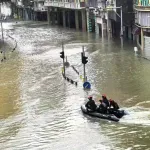By MDT,Renato Marques
Copyright macaudailytimes

Exactly thirty hours after the hoisting of Typhoon Signal No.8, which initiated the state of immediate prevention, such an alert state has ended with the downgrading of the former Super Typhoon Ragasa to Signal No.3 of warning at 11 p.m. on Wednesday, September 24.
During the 30 hours between 5 p.m. on Tuesday and 11 p.m. on Wednesday, Ragasa caused significant disruption and brought Macau to an almost complete shutdown, which is rarely seen, even during other storms of similar intensity.
The population followed the warnings of the Civil Protection Operation Center (COPC). A few hundred had to leave their homes for some 36 hours and find shelter in one of the emergency shelters created for the purpose.
Besides the wind speed nearing 200 km/h, the major concern from the local authorities, the Storm surge level, was, in the end, overestimated, with the maximum flood level seen to edge the 1.5 meters top ceiling from Orange level rather than the 2.5 meters (or more) that was aired as a serious possibility during a long period.
Contrary to Taiwan, where the Super Typhoon had earlier killed at least 15 people and caused severe damage to property and infrastructure, in Macau, the damage was far less severe, and no lives were claimed nor serious injuries caused.
Put to the real test for the first time after the passing of devastating Hato (2017) and Mangkhut (2018), the COPC structure responded well and quickly to all the solicitations and has received praise from the population.
Preparedness seemed to be the best word to explain this outcome, which also included communication with the utilities companies, namely the electricity company (CEM), which promptly organized preventive outages in areas of severe flooding to avoid more significant damage to the infrastructure, as well as potential fires caused by short-circuiting.
In the final report, 259 incidents were noted, of which the large majority (153) involved removing fallen objects such as signage, billboards, lamp posts, trees, scaffolding, and other construction-related equipment.
Eleven people got trapped inside lifts, and floodwater caused 23 cases of fire related to minor short-circuits.
In total, the authorities have recorded eight cases of injuries.
With the lowering of Signal No.8, the city resumed its regular life. Public transportation re-entered operation, and vehicles circulated on the four sea bridges between the Peninsula and Taipa Island.
The reactivation also included the resumption of activities in the local casinos, which were suspended during the 30 hours. According to information from the Gaming Inspection and Coordination Bureau, the casinos were authorized to resume their activities at 2 a.m. tomorrow (Sept. 25).
The circulation of buses on the Hong Kong-Zhuhai-Macau bridge was also reactivated, in this case to restart at 12 a.m. on Sept. 25.
The ferry operators were also authorized by the Marine and Water Bureau to resume sailings, although in this case, the authorities left it to the operator to describe when to restart sailings, namely between Macau and the neighboring region of Hong Kong. Due to the late hour, likely, sailing will only resume on the morning of Sept. 25.
At the Macau International Airport, flights also started to operate with the airport company to coordinate with airlines to open more check-in counters to facilitate the passenger flow. The Civil Aviation Authority also urged passengers to confirm their flights with the airlines before heading to the airport to avoid an unnecessary agglomeration.
According to the Education and Youth Development Bureau, classes from the tertiary and secondary education levels will resume tomorrow morning, while the restart of the primary, kindergarten, and special education levels will be subject to the typhoon situation. That is, they will only resume tomorrow morning if Signal No. 3 is lowered before 6:30 a.m.
Typhoon of Records
According to the Meteorological and Geophysical Bureau (SMG), Ragasa broke several records when passing through Macau.
The first is the first time that a Typhoon warning Signal No.10 is hoisted twice in the same year.
Second, it was the most extended period of Signal No.10 since there are records, lasting 10 hours and 30 minutes.
The SMG also noted that the maximum wind sustained for a period of 10 minutes in all districts of Macau was Force 12, with gusts reaching Force 14. Additionally, for 15 hours, the wind intensity reached or surpassed Signal No.8.



